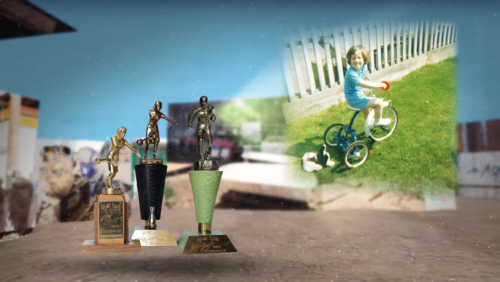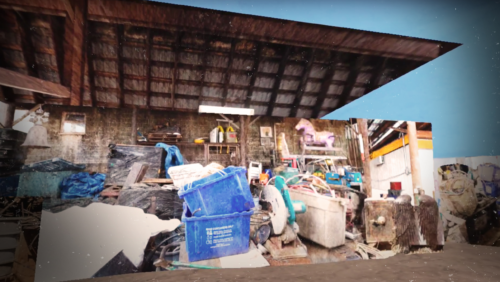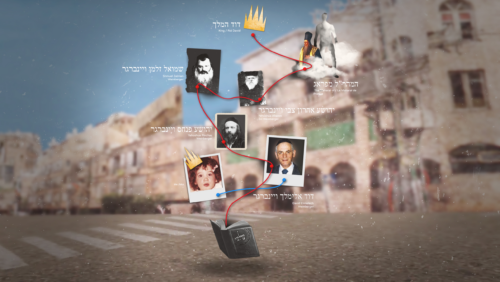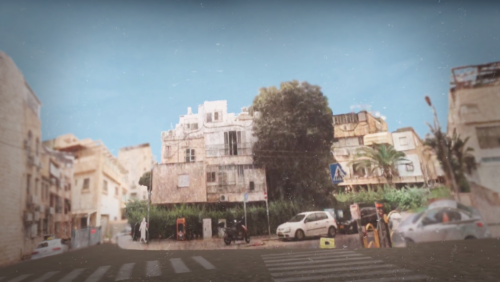Blood Relations
Liens de sang
Analee Weinberger with Dpt.
2022
| 18 min
Virtual Reality - Quest 2
English
Produced by Genetic Media, the National Film Board of Canada and Moofa Production House
With the financial participation of the Canada Media Fund, the Gesher Multicultural Film Fund, the Makor Foundation for Israeli Films, The Israel Film Council and The Israel Ministry for Culture and Sports
This project was conceived as part of New Identities, a co-production partnership in digital creation between Canada and Israel.
“What makes us who we are?” is the question that drives Blood Relations, a whimsical VR documentary about an adopted child and an ancestral mystery. Using vintage objects, photographs and ephemera, the narrator takes us on an interactive quest, from a scrapyard in Vancouver to the Orthodox Jewish community of Bnei Brak and back to a decaying farm in rural Manitoba. Each discovery adds to the visual and narrative collage, building to a surprising and thought-provoking conclusion that invites us to explore our own personal stories.
Trailer
One-liner and two-liner
One-liner
Blood Relations is a whimsical VR documentary about an adopted child and a quest to solve an ancestral mystery.
Two-liner
“What makes us who we are?” is the question that drives Blood Relations, a whimsical VR documentary about an adopted child and an ancestral mystery. In this interactive quest, Analee Weinberger takes us on a journey through surreal landscapes of personal history and invites us to consider how our own stories are created.
Long synopsis
“What makes us who we are?” is the question that drives Blood Relations, an unconventional VR documentary about an adopted child and an ancestral mystery.
Using vintage objects, photographs and ephemera from her family archives, writer/director Analee Weinberger invites us into the journey she took as an adopted child investigating her roots, discovering startling plot twists along the way.
Blood Relations is an immersive quest through surreal landscapes, from a scrapyard in Vancouver to a street corner in the Orthodox Jewish community of Bnei Brak and back to a decaying barn on a farm in rural Manitoba. The sights, sounds and characters encountered in each place evoke potential life paths that were or might have been.
As users seek and interact with objects in the environments, fragments of story are revealed. The collage of facts, memories, imagination and conjecture leads to a surprising and thought-provoking conclusion, inviting us to reflect on and explore our own personal stories.
Blood Relations is part of the New Identities initiative, an Israel/Canada co-production partnership in digital creation. The aim of the initiative is to create interactive experiences that question the narratives that have been passed on to us and which have forged our identities, with a view to reshaping them to create new identity stories.
About the user experience
Blood Relations is an interactive VR documentary that takes the form of a quest for pieces of a story that may reveal who the narrator “really” is.
Users are transported on a journey through three very different geographical locations and are instructed to search for and reach toward interactive objects in the environment that trigger short, animated fragments of the story. The gestures mirror the real-life experience of looking for clues and piecing together an origin story from many different—and sometimes contradictory—sources.
Users can be seated or standing and can navigate with either controllers or hand-tracking. The design is intended to be accessible for users with mobility or fine motor coordination limitations: interactive elements appear in a 180-degree arc in front of the user, and interactive objects are triggered by a simple reaching gesture. Users can move through the story at their own pace.
Blood Relations works with the Quest 2 headset. It is available in English and French and lasts approximately 18 minutes.
Q&A with Analee Weinberger
How did this project come about? What made you decide to turn such a personal story into a public experience?
This project came about serendipitously. Doing something with the story and the archival material had always been in the back of my mind. When I saw the NFB’s call for participants for the New Identities initiative, the story seemed like a good fit because it had to do with how the combination of DNA technologies and ancestry websites was challenging people’s traditional narratives of identity.
It’s a personal story, but the themes are pretty universal: What makes us who we are? Who decides where we belong? What connects us to others, and what do those connections mean?
Why did you choose virtual reality for this project? In what way does it add to the experience?
Blood Relations is first and foremost an exploration of what makes us who we are, and it takes viewers through three alternate paths of life that were or might have been. VR is really the ideal medium when you want someone to feel what it would be like to live in different realities: they are immersed in a particular geographical environment—the sights and sound, the characters and the family narratives specific to that life path.
You’ve managed to combine a linear narrative with a collage-style aesthetic. What went into this decision and why do you think it works well?
The story itself is a narrative collage made up of imperfect memories, stories, imagination, photos, documents, conjecture… And they don’t always fit together coherently. The visual collage is a representation of that.
The interactive element of searching and reaching for an object-clue in order to reveal a fragment of the story mirrors the real-life experience of looking for and piecing together disparate bits of information in the quest to solve the mystery of an origin story.
All of the objects you see in Blood Relations belonged to my family: the bowling trophies that my parents won in the 1950s, the silver Sabbath candlesticks, the family photos, copies of my adoption documents, my mother’s old typewriter (she was a secretary before she married). The environments are constructed of photographs of the actual locations of the story: Capital Salvage, the building in Bnei Brak that my aunt lived in, and the farm that my biological father grew up on. Collage was a natural way to combine all of these elements to tell a story in a way that brings them to life. Dpt., the studio that created the VR experience, did a phenomenal job of constructing rich immersive environments out of what were essentially 2D archival materials.
Can you talk about the Jewish aspect? Do you think your story will help demystify Judaism, or Jewish lineage, for the general public? Was this a thought when creating the project?
Blood Relations has a strong Jewish component in that I was raised in an Orthodox Jewish home and could have lived in a very different Jewish environment, but versions of this story are being discovered every day among people of different ethnicities as they learn of their genetic ancestry through at-home DNA tests and genealogy sites. Usually, the stories are about people ‘passing’ as members of a different ethnicity in order to escape persecution—for example, Jews during the Holocaust who were able to pass as Christians, or light-skinned African Americans passing as white to escape racism. I think it’s less common to claim to be a member of a historically persecuted population, but we do hear stories of that today. In Canada, we’ve seen cases in the news recently of people with a public profile who describe themselves as Indigenous but who don’t actually have Indigenous heritage.
I don’t think Blood Relations will do much to provide insight into Judaism in general and that wasn’t an intent of the project. It may create an awareness of the reasoning behind some aspects of contemporary Judaism, such as ultra-Orthodox views regarding strong community bonds and continuity of practices and lineages as a means of survival in the wake of the Holocaust.
Blood Relations also implicitly addresses the age-old question of what makes someone Jewish, and who decides that. Judaism is the identity addressed here, but any user can question their own identity(ies) in the same way.
What was your intention with Blood Relations? Did that change over the course of production?
Originally, Blood Relations was going to be much artier, but we realized early on that the story could get very confusing very quickly if it wasn’t told in a clear and quite linear way!
Other than that, we’ve stayed true to the original intention of the project, which was to invite the user on a journey of discovery that places them in the shoes of an adopted child discovering her origins, and asks questions about what makes us who we are, where we come from, and what brought us here.
How do you hope the project will be received? What do you want people to take away from it?
I think a person’s own history and experiences will affect how they respond to the project. First-generation immigrants may relate to themes of displacement and a desire to preserve a culture, while users who self-identify as Jewish may relate to the question of what makes someone Jewish.
I hope the experience is engaging and thought provoking. Perhaps the discovery of connections among these vastly different peoples and worlds in the story prompts reflection about the user’s own sense of identity, family and connection to others past and present. Maybe reflection on the ‘collage’ of beliefs, decisions, and events—both world-altering (the Holocaust) and intimate (a young woman’s choices about an unplanned pregnancy)—that contributed to one child’s life story may leave people with a sense of the innumerable elements that come together to create a singular identity. Ultimately, I hope Blood Relations leaves people with a positive sense of human interconnectedness.
Excerpts
Images
Loading...

Download
Loading...

Download
Loading...

Download
Loading...

Download
Loading...

Download
Team
Analee Weinberger
Writer, Director and Producer
Photo
Photo : Kerry Swartz
Maude Thibodeau
Experience Director (Dpt.)
Photo
Photo : Anouk Lessard, L'Éloi
Nicolas S. Roy
Creative Director (Dpt.)
Photo
Daniella Koffler
Producer (Moofa Production House)
Photo
Marie-Pier Gauthier
Producer (NFB)
Photo
Photo : NFB
Isabelle Repelin
Producer (NFB)
Photo
Photo : Valérie Sangin
Louis-Richard Tremblay
Executive Producer (NFB)
Photo
Photo : NFB
Credits
Original Idea
Analee Weinberger
Written and Directed by
Analee Weinberger
Art Direction, Concept, Design and Programming
Dpt.
Music and Sound Design
Eitan Shefer
Video Design and Animation
Dpt.
Narration
Analee Weinberger
DPT. TEAM
Creative Director
Nicolas S. Roy
Experience Director
Maude Thibodeau
Producer
Raphaëlle Sleurs
Unity Developer
Louis Thériault Boivin
Motion Designer
Nicholas Peek
COLLABORATORS
Photographers
Kerry Swartz (Vancouver)
Eitan Shefer (Bnei Brak)
Colin Corneau (Manitoba)
Story Consultants
Daniella Koffler
Sophy Romvari
Narration Revised and Translated by
Carl Bessette
Voice-over Director
Dale Wolfe
Assistant Sound Editor (french version)
Nataq Huault (Bande à part)
Recording Studio
On the Mic Training
Sound Recording
Adam Inocencio Cummings
PRODUCTION TEAM
Producer – Genetic Media
Analee Weinberger
Producer – Moofa Production House
Daniella Koffler
NFB INTERACTIVE STUDIO
Producers
Marie-Pier Gauthier
Isabelle Repelin
Executive Producer
Louis-Richard Tremblay
Senior Production Coordinator
Véronique Tessier
Technology Director
Martin Viau
Interactive Media Coordinator
Caroline Fournier
Administrator
Marie-Andrée Bonneau
Senior Administrative Coordinator
Isabelle Limoges
Production Coordinator
Isabelle Gatti
Evelyne Cortes Oquendo
Legal Services
Christian Pitchen
Project Manager, Digital Products
Catherine Perreault
Technical Coordinator (post-production)
Mira Mailhot
Additional Sound Mix
Geoffrey Mitchell
Marketing Manager
Laurianne Desormiers
With the contribution of the Interactive Studio team
Marie-Ève Babineau
Valérie Darveau
Steve Hallé
Johanna Lessard
Sylvain Cajelais
Frank Nadeau
Sergiu Suciu
Archives
The collection of the Jewish Museum in Prague
Syms family collection
Toronto Public Library Digital Archive
Weinberger family collection
With the financial participation of
Canada Media Fund
The Gesher Multicultural Film Fund
The National Film Board of Canada
Makor Foundation for Israeli Films
The Ministry for Culture and Sports
The Israel Film Council
This project was made possible thanks to the New Identities initiative, launched with the valuable contribution of:
The Consulate General of Israel in Montreal
Festival du nouveau cinéma
The Haifa International Film Festival
HUB Montréal
Xn Quebec
THANK YOU
For the Canada Media Fund
Nathalie Clermont
Stéphane Consentino
Marie-France Thérien
Marilou Loncol-Daigneault
For the Gesher Multicultural Film Fund
Ziv Naveh – CEO
Tal Haring
Guy Ofran
Sharon Shamir
Miriam Ben Yosef
Yael Yakirevich
Liron Benzguida Partush
For the Makor Foundation for Israeli Films
Amit Goren
Eveline Kluger Kadish
Nir Sa’ar
Special thanks to
Dov and Jen Dimant, Capital Salvage
Mary Hoorne and Gerard Hoorne
Julia Ivanova
Fiona Tinwei Lam
Fiona Morrow
Naomi Youngson and clan
Project supported by
Asylum Arts
© 2022 Genetic Media, National Film Board of Canada, Moofa Production House
Media Relations
-
About the NFB
The National Film Board of Canada (NFB) is one of the world’s leading digital content hubs, creating groundbreaking interactive documentaries and animation, mobile content, installations and participatory experiences. NFB interactive productions and digital platforms have won over 100 awards, including 21 Webbys. To access this unique content, visit NFB.ca.